Last updated: October 9, 2025
Quick Answer
There isn’t one “right” price for a French Bulldog. Think in three buckets—upfront, monthly, and annual—then localize by where you live. Country rules, city service rates, housing pet fees, and your choices (insurance, travel, training) all shift the total. Start with paperwork-first sourcing, then build a simple local worksheet you can refresh each year.
Key Takeaways
- Budget in three columns: Upfront (registration/ID, starter kit), Monthly (food, insurance if you choose, general preventatives), Annual (license renewal, boarding/travel, gear refresh).
- Region matters: Urban services, insurance adoption, pet rent, and holiday travel timing make costs diverge across US states, UK areas, and Canadian provinces.
- Paperwork over hype: Use registry and breed-club directories; avoid color marketing claims and vague listings.
- Localize your numbers: Add your town’s license fee, a boarding day rate, a training class price, and a real insurance quote to build a state/province range.
- Update yearly: Prices move; a 10-minute refresh keeps your plan honest.
For health concerns, consult your veterinarian.
Why a framework beats a single “price”
Frenchie costs vary for sensible reasons. City grooming and daycare run higher than rural rates; insurance premiums change by postal code; landlords may charge pet rent or deposits; and holiday boarding spikes each December. Across countries, rules differ too: the UK mandates microchipping and has robust insurance adoption, while licensing and fees vary widely across the US and Canada. A framework lets you scale up or down without chasing unreliable “national averages.”
The cost framework (Upfront • Monthly • Annual)
A) Upfront (one-time)
- Registration and ID: AKC or CKC registration as applicable; microchip registration; city/county pet license where required.
- Starter kit: crate, bed, bowls/mats, leash/harness, collar and ID tag.
- Transport safety: carrier or car restraint.
- Training start: first group class or foundational online program.
- Basic grooming kit: brush, nail tool, gentle shampoo, wipes.
- Insurance (optional): if you want predictable expenses, start the policy now so it’s in the monthly bucket from day one.
B) Monthly (recurring)
- Food plan: quality level and format (kibble, fresh, or mixed) + buying cadence (bulk vs. small bags).
- Pet insurance premium (optional): choose a deductible you can truly afford.
- General preventatives (non-brand framing): follow labels and local requirements.
- Enrichment: toys, chews, puzzle feeders; set a modest cap.
- Grooming consumables: shampoo refills, wipes; nail tool replacement over time.
- Training refreshers: occasional drop-in classes or a training app if you like structured practice.
C) Annual (recurring)
- License renewal (where required) and a simple ownership visit line in your budget (we’re not giving treatment advice—just acknowledging it’s a recurring cost bucket).
- Boarding or pet-sitting for travel period(s); holiday weeks fill first and often cost more.
- Gear refresh: harness, leash, beds, or crate parts that wear out.
- Contingency cushion: pet rent/deposits, sitter backup, or last-minute travel needs.

Country snapshots (identity, paperwork, and planning context)
United States
- Identity & sourcing: The American Kennel Club provides the breed overview and a Marketplace directory that’s useful as a starting point—review contracts and paperwork carefully:
- AKC breed page: https://www.akc.org/dog-breeds/french-bulldog/
- AKC Marketplace (directory): https://marketplace.akc.org/
- Ethics lens: The French Bulldog Club of America (FBDCA) offers a breeder referral and a Code of Ethics:
- FBDCA referral: https://frenchbulldogclub.org/breeders/
- FBDCA Code of Ethics: https://frenchbulldogclub.org/code-of-ethics/
- Budget notes: Licensing is local; daycare/boarding and training are highly metro-dependent. Pet rent or pet deposits may apply in some rentals. Insurance is optional—decide based on your risk tolerance.
United Kingdom
- Buyer guidance:The Kennel Club sets out buyer checks, contract awareness, and readiness—including insurance reminders:
- Getting a Dog: https://www.thekennelclub.org.uk/getting-a-dog/
- Buying a Dog: https://www.thekennelclub.org.uk/getting-a-dog/buying-a-dog/
- Admin context: Microchipping is a legal requirement; council licensing rules can vary:
- GOV.UK microchipping: https://www.gov.uk/get-your-dog-cat-microchipped
- Budget notes: Insurance uptake is comparatively high; daycare/boarding and holiday travel timing influence spend; address any landlord pet terms upfront.
Canada
- Registry & directory: The Canadian Kennel Club provides fees context and a Puppy List directory:
- Budget notes: Municipal licensing varies; urban training/boarding rates can be closer to large US metro levels. Weather and travel patterns also affect boarding versus bring-along decisions.
Simple table: Directory & paperwork snapshot
| Region | Registry / Club Resource | What it’s for | Notes |
|---|---|---|---|
| USA | AKC Marketplace; FBDCA Breeder Referral | Paperwork-first sourcing | Start here; review contracts and ethics. Avoid color-marketing claims. |
| UK | The Kennel Club – Buying a Dog | Buyer checks & documentation | Insurance planning encouraged; microchipping is mandatory. |
| Canada | CKC Puppy List; CKC Fees | Member-breeder directory & fee context | Use directories, verify contracts, and keep copies of all paperwork. |
(Use these as directories, not price guides. Evaluate each breeder or rescue on transparency, temperament, and fit.)
Regional cost drivers (what actually changes your number)
- Housing costs: Pet rent/deposits or landlord clauses (US/Canada); clarify before signing.
- Service rates: Training, grooming, daycare, and boarding differ by metro size and season.
- Insurance choices: A monthly premium can smooth out volatility; self-funding requires discipline.
- Travel habits: Boarding vs. pet-friendly hotels, peak travel surcharges, and transport logistics add up.
- Sourcing logistics: Distance to responsible breeders or rescues (fuel, time, sometimes lodging) is a line item many forget.
- Currency & taxes: Converting USD/GBP/CAD and local taxes/fees can shift totals year to year.
Build a state-by-state (or province-by-province) worksheet
Rather than memorize someone else’s number, take 10 minutes to build your own.
- Local admin: Add your license fee and renewal month. If you’ve moved, put “microchip registry update” on the same page so everything matches.
- Services: Call or check sites for a boarding/daycare day rate and a basic group training price in your metro (or nearest town).
- Insurance: Pull one quote for your ZIP/postcode with a deductible you can afford; write in the real premium.
- Food plan: Choose your quality tier and bag size. If you buy in bulk, note the monthly equivalent.
- Annual buffer: Add a modest cushion for gear refresh, sitters, and travel spikes.
- Set a calendar reminder: Revisit this sheet once a year—prices change.
Myths and marketing to ignore
- “There’s one right price for a Frenchie.” Markets, housing, insurance choices, and travel patterns differ.
- “Rare color equals higher value.” Registries use specific color wording and standards; color hype isn’t a budgeting tool. If color terminology confuses listings, this coat-color overview from UC Davis VGL is a neutral glossary: https://vgl.ucdavis.edu/resources/dog-coat-color
- “Upfront is the whole story.” Monthly and annual spending are where real ownership lives.
- “Skipping insurance always saves.” Some owners prefer predictable costs; others self-fund. Run both scenarios in your sheet.
Responsible sourcing (ethics-first, non-medical)
- Use official directories: AKC Marketplace, FBDCA referral, The Kennel Club buyer resources, CKC Puppy List.
- Check the paperwork: registration status, health/ownership documentation provided by the seller, microchip details, and return clauses.
- Avoid color-only decisions: temperament, structure, and transparency matter more than a marketing label.
- Keep copies: store digital PDFs of contracts, registrations, microchip confirmation, licenses, insurance policy, and a simple photo ID set.
Practical checklist: receipts & records (so your budget stays honest)
- Setup folder: contract, registry confirmation(s), microchip registration, license receipt, insurance policy PDF.
- Monthly tracker: food invoice, insurance bill, enrichment purchases.
- Annual notes: license renewal reminder, boarding/travel reservations, gear replacements.
- File naming habit: “YYYY-MM-Item.pdf” (e.g., “2025-11-Microchip-Update.pdf”)—you’ll find documents in seconds when a landlord or airline asks.
FAQs
How should the first-month budget be structured?
Combine the “boring but real” admin (registration, microchip update, license) with a starter kit (crate, bed, bowls, leash/harness, ID tag), transport safety, a beginner training enrollment, and—if you choose—your first insurance premium. Add a small cushion for missed items.
What tends to change from puppy to adult monthly costs?
Training often tapers or becomes occasional; food may increase or decrease depending on size and activity; you’ll likely replace cheap gear with durable items. Insurance premiums and coverage choices can evolve over time.
What makes one US state or Canadian province feel more expensive than another?
The biggest levers are local service rates (boarding, daycare, training), housing pet fees, and travel patterns. That’s why a local worksheet beats national averages.
Is rescue automatically cheaper than buying from a breeder?
Adoption fees can be lower, but you still have setup, monthly, and annual costs. Compare both paths using the same three-column framework so you’re not skipping line items in one path and counting everything in the other.
What paperwork should be saved to prove ownership and planning?
Contracts, registry confirmations, microchip registration, license receipts, insurance policy, and a small photo ID set (clear tag and face shots, saved with sensible file names).
How often should the budget be reviewed?
At least annually. Costs for services and travel shift, and insurance or housing terms can change. A yearly refresh keeps surprises off your calendar.
Sources used
- American Kennel Club — French Bulldog (breed page): https://www.akc.org/dog-breeds/french-bulldog/
- AKC — Know the True Cost of Owning a Dog: https://www.akc.org/expert-advice/lifestyle/know-true-cost-owning-dog/
- AKC Marketplace (directory): https://marketplace.akc.org/
- French Bulldog Club of America — Breeder Referral: https://frenchbulldogclub.org/breeders/
- French Bulldog Club of America — Code of Ethics: https://frenchbulldogclub.org/code-of-ethics/
- The Kennel Club (UK) — Getting a Dog: https://www.thekennelclub.org.uk/getting-a-dog/
- The Kennel Club (UK) — Buying a Dog: https://www.thekennelclub.org.uk/getting-a-dog/buying-a-dog/
- GOV.UK — Microchipping your dog or cat: https://www.gov.uk/get-your-dog-cat-microchipped
- Canadian Kennel Club — Schedule of Fees: https://www.ckc.ca/en/Files/Forms/Schedule-of-Fees
- Canadian Kennel Club — Puppy List: https://www.ckc.ca/Choosing-a-Dog/PuppyList/Default.aspx
- ASPCA — Cutting Pet Care Costs: https://www.aspca.org/pet-care/general-pet-care/cutting-pet-care-costs
- UC Davis VGL — Dog Coat Color (glossary-level overview): https://vgl.ucdavis.edu/resources/dog-coat-color



